by the Center for Human-Carnivore Coexistence (5/20)
Key Points….
- Colorado supports an abundant prey base for wolves. This includes over 430,000 mule deer and 280,000 elk, the largest elk population of any state. The largest mule deer and elk herds occur in western Colorado.
- If occurring in high enough population numbers for enough time, wolves in Colorado might locally impact some big game herds and hunting opportunities. This is more likely if wolf predation acts with other factors that limit prey such as severe winters.
- At a statewide level, wolves are unlikely to have a major impact on overall big game populations or hunting opportunities in Colorado based on evidence from northern Rocky Mountain states.
Impacts of Wolves on Big Game and Hunting
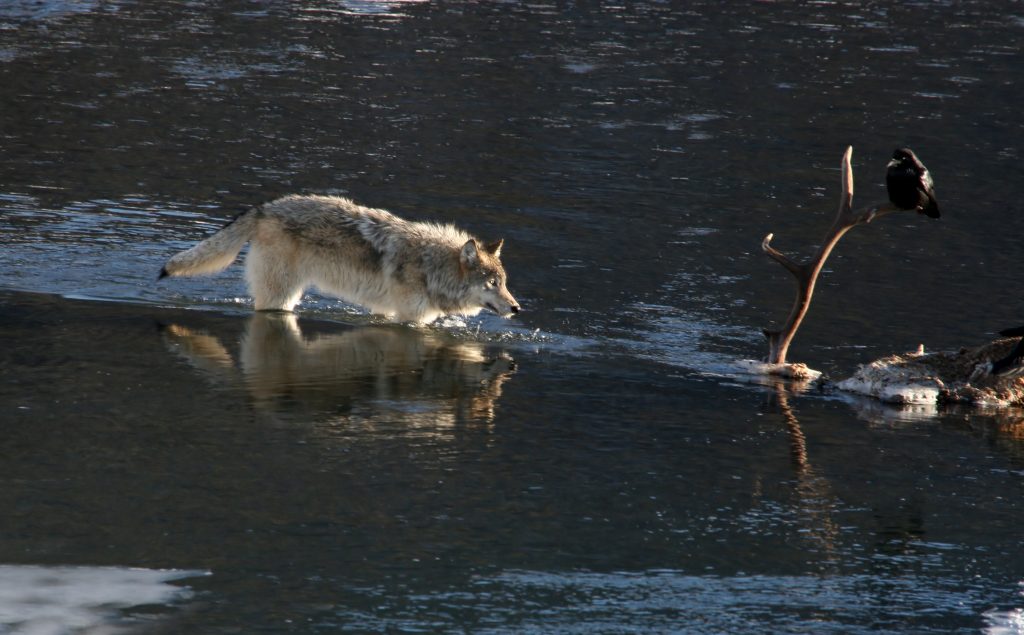
The impact of wolves on elk, deer, and other big game is complicated. Wolves chase down their prey and often target old and weak animals that might have otherwise died from starvation or disease.1 Also, the hunting success rates for wolves are low. Typically, over 80% of hunting attempts end unsuccessfully.2 Under such conditions, wolves alone are unlikely to reduce big game populations.
Wolves can contribute to local declines in the number of prey. This is more likely when harsh weather, other predators (e.g., bears, cougars, coyotes), or human hunters also kill animals.1 Wolves also can make big game more wary, move more, and use habitat differently by seeking more cover.3 This would make hunting more challenging in some areas. Similarly, human hunters can also alter movement and habitat use of big game.4
Elk and Wolves in the Northern Rocky Mountains
In states with wolves, abundant big game and hunter harvests can still occur. Such is the case for many states with wolves including Alaska; the Great Lake States of Minnesota, Wisconsin, and Michigan; and the northern Rocky Mountain States of Wyoming, Montana, Idaho. In much of the northern Rocky Mountains, including in Yellowstone National Park, elk are the primary prey of wolves.5 Elk post-hunt population sizes6-9 (Figure 1) and hunter harvest of elk10-13 (Figure 2) in Wyoming, Montana, and Idaho have not declined since wolves were reintroduced starting in 1995. Note that these estimates of population sizes are made after the hunting season, representing the number of elk available after hunters had the opportunity to hunt.

Figure 1. Post-hunt elk population sizes in northern Rocky Mountain States since wolf reintroduction. Data compiled from state wildlife agencies.6-9
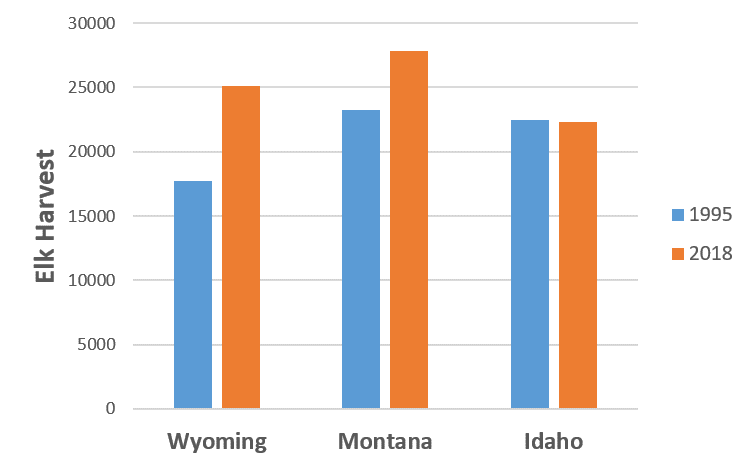
Figure 2. Elk harvest in northern Rocky Mountain States since wolf reintroduction. Data compiled from state wildlife agencies.10-13
Montana provides a useful case study. At a statewide level, elk population sizes7 (Figure 3) and elk harvested by hunters11 (Figure 4) have been stable since 2004 despite a rapid increase of wolves until around 2013.14 Wolf hunting was allowed in Montana starting in 2009.
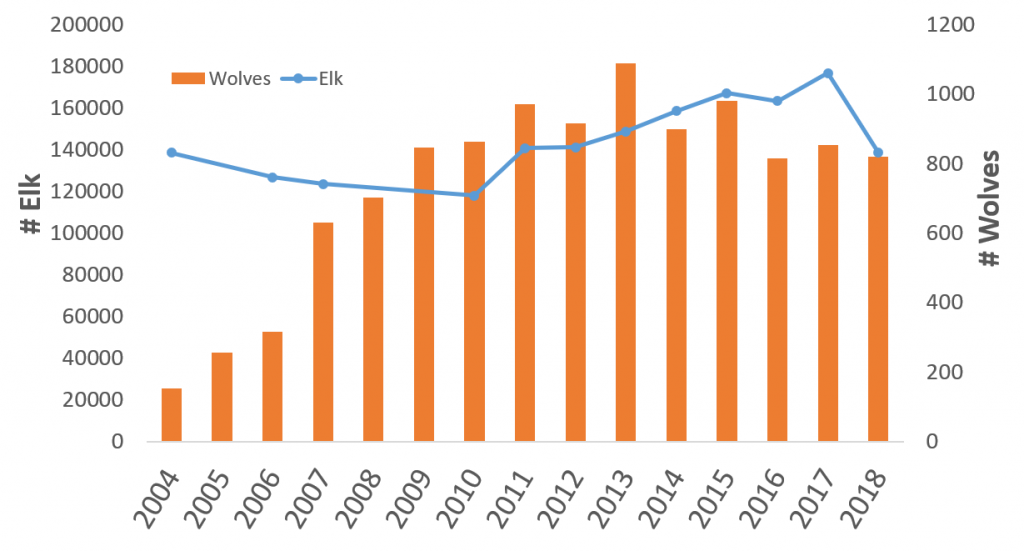
Figure 3. Montana elk and wolf population sizes. Data compiled from Montana Fish, Wildlife & Parks.7,14
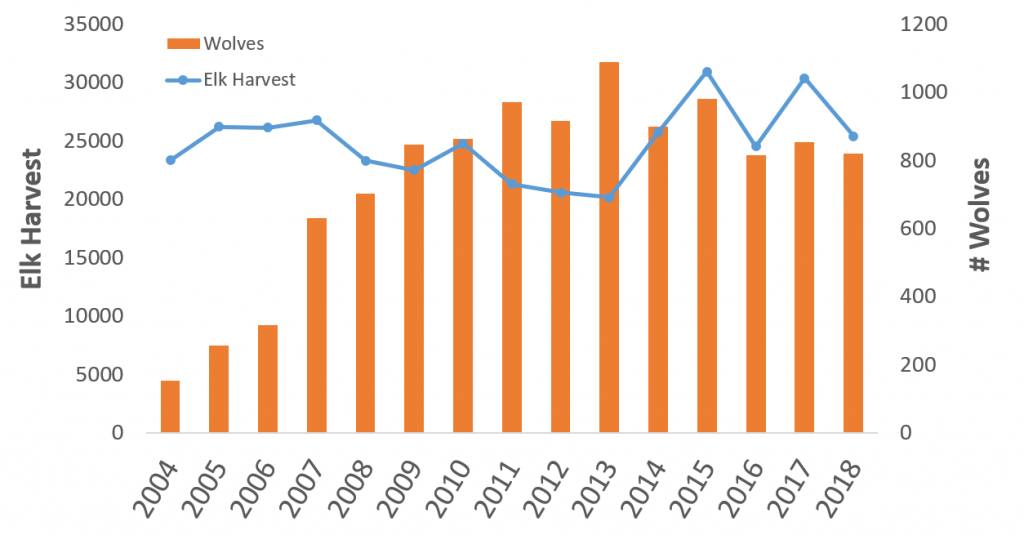
However, wolves do not occur across all of Montana. The most appropriate comparison is in regions where both wolves and elk interact. Wolves live in the western part of Montana (purple circles in Figure 5).14 Elk are distributed farther east than wolves, into central Montana (green shading in Figure 6).7
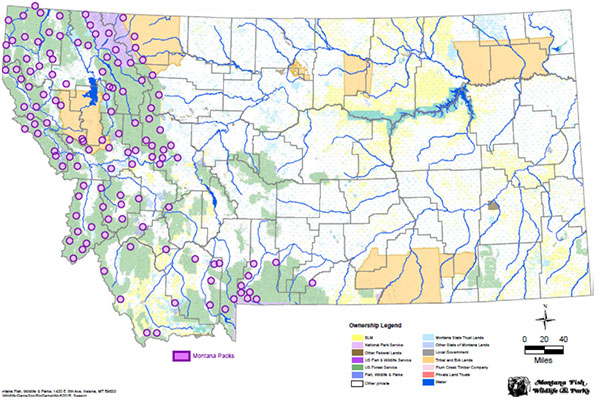
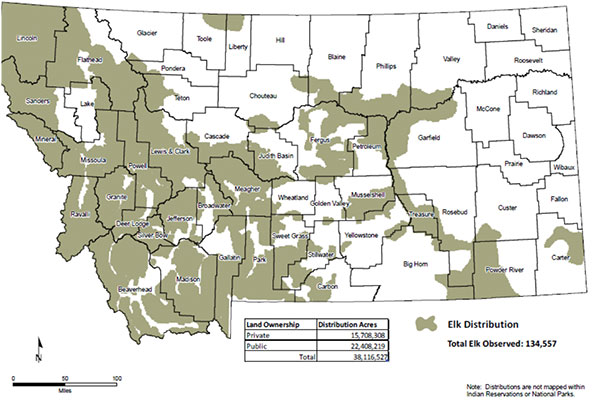
In western Montana, where both wolves and elk live, elk harvest by hunters has been steady or increasing in many places.15 Elk population sizes are at or above objectives set by the state game agency in most hunting districts in the state (red and green in Figure 7).7 This includes areas with wolves, including near Yellowstone in the southwest corner of the state. Yet in other areas, elk numbers have declined, due in part to wolf predation.15 Some elk hunting districts are currently below population objectives set by the state (yellow in Figure 7).
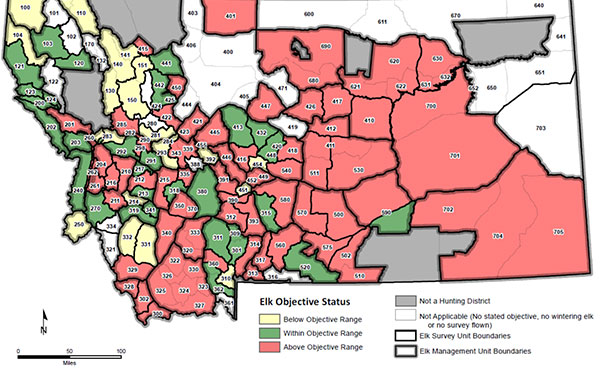
Similarly, in Idaho, elk herds currently are within or above management objectives in 17 of 22 elk management zones.8 However, some elk herds are below population objectives. This is the case in the Lolo Zone in northern Idaho. According to Idaho Department of Fish and Game, wolves and other predators have contributed to local declines of elk herds, along with habitat degradation and harsh winters. In response, the agency has conducted regulated hunting and targeted control efforts to reduce wolf populations in the area.16 In Wyoming, most elk herds also are above population objectives. In 2019, Wyoming Game and Fish estimated that elk populations are 29% above objective for those herds it counts.6
Mule Deer and Wolves in the Northern Rocky Mountains
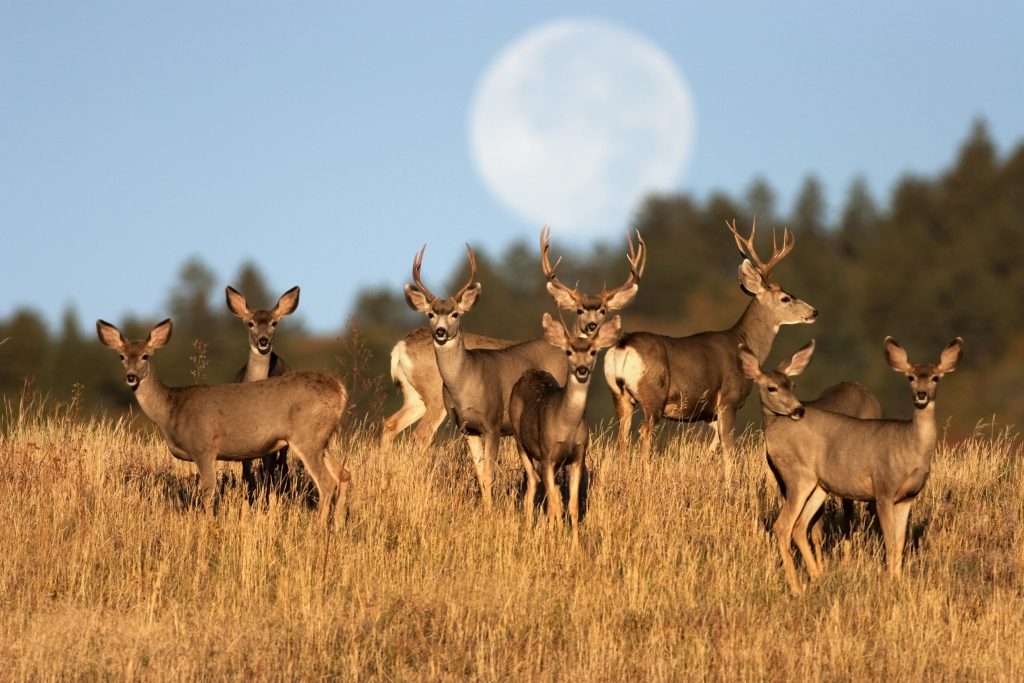
Hunter harvest for mule deer also has been relatively stable over the past 10 years in Wyoming10, Montana11, and Idaho.12 Compared to elk, however, mule deer are more often below population objectives set by state wildlife agencies. This in part reflects a decline in mule deer populations in recent decades throughout the Rocky Mountain West. This decline is thought to be driven by a combination of factors. Loss and degradation of habitat due to residential and energy development, invasive weeds, and encroaching tree cover are important. Weather, including severe winters and drought, also impact mule deer. Other factors, including disease, competition with elk, hunting, and predation may also contribute to localized declines. Wolves eat mule deer and can impact populations in some situations. However, the quantity and quality of habitat, more than predation, typically determine how many mule deer can be supported on a landscape.17-18
Moose and Wolves in the Northern Rocky Mountains
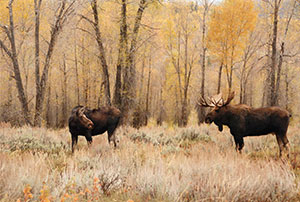
Moose are relatively recent arrivals to parts of the U.S. Rockies.19-25 Moose likely immigrated from Montana and Idaho to Wyoming in the 1850’s. Restrictions on moose hunting, forest fire suppression, and predator control programs led moose to become abundant in the northern Rocky Mountains by the mid-late 1900s. Historically, moose were rare in Colorado, with only a few stray animals wandering in from Wyoming.23-25 These strays were probably just transient animals seeking new habitats, but they never came in large enough numbers to establish a stable population. A moose population was established in Colorado with the introduction of moose into north-central Colorado in the late 1970s. Additional moose were reintroduced to the Creede area in south-central Colorado between 1991-1993 and to the Grand Mesa in west-central Colorado between 2005-2007.25 Since then, populations have increased to nearly 3000 moose.
Moose populations have declined over the past 30-40 years through much of the U.S. The exact causes are unknown. Similar to mule deer, the decline is likely due to a variety of factors. These include habitat loss and degradation, wildfires, human development, parasites, and predation. Climate may also limit moose. Moose are adapted for cooler conditions. But, in the lower U.S., they are living in a warming climate at the southern edge of their natural range.
In the northern Rocky Mountains, predation of moose calves by grizzly bears, black bears, and wolves may contribute to moose declines. However, in Wyoming, low pregnancy rates and malnourishment were the primary limits on moose populations.22 Also, moose are declining in areas where wolves are rare or absent. This includes southwestern Wyoming and other regions of the West. Wolves are not the primary cause of moose decline across their range. Habitat quantity and quality, including healthy willow and aspen communities, strongly influence moose populations.21
Potential Impacts of Wolves in Colorado
Overall, the effect of wolves on big game populations and hunting opportunities is complex. Sweeping generalizations are difficult. Ultimately, if occurring in high enough population numbers for enough time, wolves in Colorado might contribute to local reductions of some big game herds in some areas, especially in combination with habitat degradation, other predators, and human hunting. If so, this might reduce hunting opportunities for some herds.26 Big game herds that are small or isolated might be more susceptible to wolf predation impacts. However, overall, based on evidence from northern Rocky Mountain states, wolves will likely have a relatively low impact on big game and hunting at a statewide level.
If wolves re-establish in Colorado, either naturally or through reintroduction, it will likely be initially on the Western Slope. As such, elk and mule deer would be the primary prey. Colorado supports a sufficient prey base for wolves.27 Over 430,000 mule deer live in the state.28 Colorado also supports over 280,000 elk, the largest elk population of any state.28 The largest big game herds occur on the Western Slope. Colorado Parks and Wildlife (CPW) considers some elk herds as overabundant.29 In 2018, 19 of the state’s 42 elk herds (45%) exceeded population objectives set by CPW. 18 of the 42 herds (43%) were within 10% of their target population objective. CPW has been actively working to reduce overpopulated elk herds to limit damage to crops and livestock forage. In FY2018, CPW paid out $95,755 in claims due to elk damage. In this context, if wolves help reduce overabundant elk herds causing damage, this might be viewed as beneficial. Only 4 (10%) out of the state’s 42 elk herds were below objective targets in 2018. In particular, herds in the southwest corner of the state have been recently declining. Long-term drought and increasing human development are likely contributing causes.
As in the northern Rocky Mountains, mule deer in Colorado are more often below population objectives than elk.29 In 2018, 10 out of 54 deer herds (19%) exceeded their population objective by more than 10%. In FY2018, CPW paid out $28,660 in claims due to deer damage. 25 out of 54 deer herds (46%) were below their population objective targets.
Ultimately, wildlife managers have a variety of tools to manage predators, big game, and hunter harvest. One tool is regulated harvest of both predators and big game. Harvest can be manipulated to achieve management objectives for predator and prey populations. Harvest of wolves in Colorado would be possible only if they are no longer protected under the U.S. Endangered Species Act and are classified as a game species by Colorado Parks and Wildlife. Also, habitat quality is often more important than predation in driving population dynamics of big game, including in Colorado.17,30-31 Thus, another management tool to ensure thriving herds and hunting opportunities is to improve big game habitat. This can include habitat restoration to improve forage quality. Reducing habitat degradation due to human development is also important. Scientific monitoring of populations of both predators and big game can ensure that the numbers of predators and prey has achieved the desired balance.
References
- Mech, L.D., 2012. Is science in danger of sanctifying the wolf?. Biological Conservation, 150(1), pp.143-149.
- Mech, L.D., Smith, D.W. and MacNulty, D.R., 2015. Wolves on the hunt: the behavior of wolves hunting wild prey. University of Chicago Press.
- Creel, S., Winnie Jr, J., Maxwell, B., Hamlin, K. and Creel, M., 2005. Elk alter habitat selection as an antipredator response to wolves. Ecology, 86(12), pp.3387-3397.
- Proffitt, K.M., Grigg, J.L., Hamlin, K.L. and Garrott, R.A., 2009. Contrasting effects of wolves and human hunters on elk behavioral responses to predation risk. The Journal of Wildlife Management, 73(3), pp.345-356.
- National Park Service. 2020. Gray Wolf.
- Wyoming Game and Fish Department. 2019. Game and Fish Commission Annual Reports ; https://www.wyofile.com/elk-populations-above-objective-as-hunting-season-heats-up/
- Montana Fish, Wildlife, and Parks. 2022. Montana Statewide Elk Management.
- Idaho Department of Fish and Game. 2022. Big Game Seasons and Rules.
- Rocky Mountain Elk Foundation. 1997. Status of elk in the West. Pages 11-13 in J.C. DeVos, Jr., ed. Proceedings of the 1997 Deer/Elk Workshop, Rio Rico, Arizona. Arizona Game and Fish Department. Phoenix, AZ.
- Wyoming Game and Fish Department. 2020. Annual Reports of Big and Trophy Game Harvest.
- Montana Fish, Wildlife, and Parks. 2020. Harvest Estimates.
- Idaho Department of Fish and Game. 2020. Harvest, hunter numbers down for deer and elk in 2019.
- Cox, M., Wasley, T., Copper, J. 2007. Status and trend of population and harvest for deer and elk in Western North America, 1970-2003. Pages 56-76 in M. Cox, ed. Proceedings of the 6th Western States and Provinces Deer and Elk Workshop – 2005. Nevada Department of Wildlife. Reno, NV.
- Montana Fish, Wildlife, and Parks. 2018. 2018 Annual Report: Wolf Conservation & Management.
- Montana Fish, Wildlife, and Parks. 2020. Wolves and Big Game in Montana.
- Idaho Department of Fish and Game. 2020. Control actions in February removed 17 wolves from the Lolo elk zone.
- Bergman, E.J., Bishop, C.J., Freddy, D.J., White, G.C. and Doherty Jr, P.F., 2014. Habitat management influences overwinter survival of mule deer fawns in Colorado. The Journal of Wildlife Management, 78(3), pp.448-455.
- Hurley, M.A., Unsworth, J.W., Zager, P., Hebblewhite, M., Garton, E.O., Montgomery, D.M., Skalski, J.R. and Maycock, C.L., 2011. Demographic response of mule deer to experimental reduction of coyotes and mountain lions in southeastern Idaho. Wildlife Monographs, 178(1), pp.1-33.
- Yellowstone National Park. 2020. Moose.
- Wyoming Wildlife Federation. 2017. How are Wyoming’s Moose Doing?
- Smith, M.A., Kilpatrick, S., Younkin, B., Work, L. and Wachob, D. 2012. Assessment of crucial moose winter habitat conditions in western Wyoming. Alces 47, pp.151-162.
- Berger, J., Testa, J.W., Roffe, T. and Monfort, S.L., 1999. Conservation endocrinology: a noninvasive tool to understand relationships between carnivore colonization and ecological carrying capacity. Conservation Biology, 13(5), pp.980-989.
- Bailey, A.M., 1944. Records of moose in Colorado. Journal of Mammalogy, 25(2), pp.192-193.
- Duvall, A.C. and Schoonveld, G.S., 1988. Colorado moose: reintroduction and management. Alces, 24, pp.188-194.
- Colorado Parks and Wildlife. 2020. Moose.
- Kunkel, K. and Pletscher, D.H., 1999. Species-specific population dynamics of cervids in a multipredator ecosystem. The Journal of wildlife management, pp.1082-1093.
- Mech, L.D., 2017. Where can wolves live and how can we live with them?. Biological conservation, 210, pp.310-317.
- Colorado Parks and Wildlife. 2020. Elk and Deer Hunting Statistics.
- Colorado Parks and Wildlife. Gamehttps://cpw.state.co.us/aboutus/Pages/GameDamage.aspx Damage Report.
- Johnson HE, Sushinsky JR, Holland A, Bergman EJ, Balzer T, Garner J, Reed SE. Increases in residential and energy development are associated with reductions in recruitment for a large ungulate. Global Change Biology. 2017 Feb;23(2):578-91.
- Lukacs, P.M., Mitchell, M.S., Hebblewhite, M., Johnson, B.K., Johnson, H., Kauffman, M., Proffitt, K.M., Zager, P., Brodie, J., Hersey, K. and Holland, A.A., 2018. Factors influencing elk recruitment across ecotypes in the Western United States. The Journal of Wildlife Management, 82(4), pp.698-710.
Science-based education is a central mission of CSU. Information Sheets within the People and Predators Series provide scientific information on interactions between humans and carnivores and have undergone review by scientists both within and outside CSU. These Information Sheets are intended to educate the public and inform science-based policy but are not intended to state a position on any particular policy decision. (5/20)





